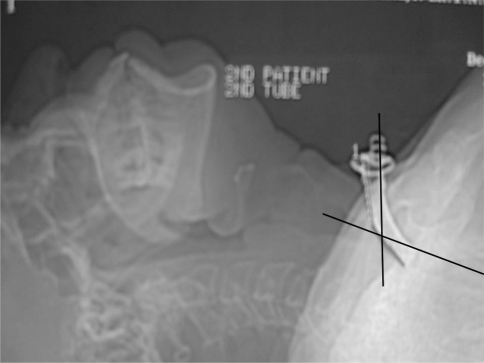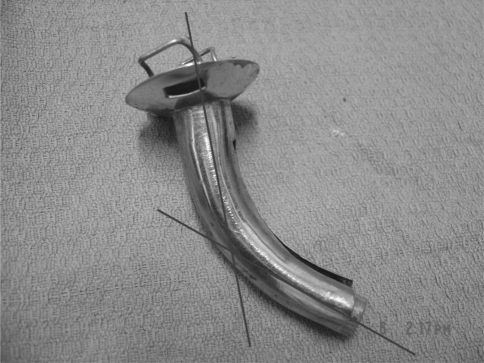Abstract
Twenty patients in the age group of 45–55 years with carcinoma of larynx underwent tracheostomy for acute upper airway obstruction. Tracheostomy tubes (no. 36) commonly available in the market have varying angle of curvatures ranging from 120° to 130°. In respect of different curvatures of the tracheostomy tubes, the various complaints of the patients were noted. The mean ideal angle of curvature of the tracheostomy tube should be 112° that was calculated from CT scan of neck with tube in situ.
Keywords: Metallic tracheostomy tube, Curvature of the tubes
Introduction
The operative procedure of tracheostomy is actually a very ancient one. The procedure was described on Egyptian tablets dating back to 3600 BC. The earliest known references to tracheostomy are made in the Rigveda published around 2000 BC. Lorenz Heister coined the term tracheotomy in 1718 [1]. The metallic tracheostomy tubes are available in various sizes and styles from several manufactures. The dimensions of tracheostomy tubes are given by their inner diameter, outer diameter, length and curvature [2]. But with the same inner diameter the curvature of the tubes from different manufactures varies, which is not commonly appreciated but may have clinical implication. There is a dearth of the study regarding the ideal curvature of the tube that appropriately fits into the patients [3]. A tracheostomy tube whose distal portion is not collinear with the trachea may cause complications like oesophageal obstruction or partial occlusion of the tracheostomy tube tip by the tracheal wall. Other possible complications are tracheal wall erosion, tracheo-innominate artery fistula, tracheo-oesophageal fistula and stomal breakdown [4]. Curvature should be such that the distal portion of the in situ tracheostomy tube should be concentric and collinear with the trachea. Assessment of appropriate curvature requires neck/chest radiographs [5].
So the main objective is to study the ideal curvature of the metallic tracheostomy tubes used in adult male patients following tracheostomy and its correlation with subjective compliance in respect to irritative cough, dysphagia and expulsion of the tube as well as objective finding like tip of the tracheostomy tube touching the posterior wall of the trachea.
Materials and Methods
The study was conducted in the department of ENT, which included 20 patients with carcinoma of larynx undergoing tracheostomy from Nov. 2005 to May 2006. All the cases had acute upper airway obstruction in advanced cases of carcinoma of larynx in the age group of 45–55 years with male predominance (male-16, female-4). Following thorough market survey it was found that the tracheostomy tubes of adult size (no.36) available were of varying curvatures ranging from 120° to 130°. The curvature of metallic tracheostomy tube was determined by the angle formed by the line passing through the horizontal part of the tube that intersects the line passing through the vertical part of the tracheostomy tube. Three tubes with curvatures of 120°, 125° and 130° were picked up for the study. All the patients had undergone tracheostomy and the tubes with same diameter but different curvatures were introduced. In respect of different curvatures of the tubes, various complaints of the patients like dysphagia, irritative cough and expulsion of the tube from trachea were noted for each tube for 24 h. Each patient was then subjected to CT scan of neck with the tube in situ in supine position. The position of the tube in respect to tracheal lumen as well as to the neck was noted in each case. A line is passed through the stoma and another line is passed through the longitudinal lumen of trachea—the point where these two lines intersect is the angle that should be the ideal curvature of the tracheostomy tube. (Fig. 1).
Fig. 1.
Photograph showing calculation of ideal curvature of tracheostomy tube from CT scan of neck and a non-ideal tube touching the posterior tracheal wall
A custom-made metallic tracheostomy tube was made. The curvature of this custom made tube was same as to the ideal curvature of the tracheostomy tube as determined from the CT scan of the neck of the patient with each tube in situ. Patients’ complaints in respect of dysphagia, irritative cough and expulsion of the tube were noted with the custom made tube in each patient. Objective finding like tip of the tracheostomy tube touching the posterior wall of the trachea was also noted with the custom made tube.
Observation and Result
The present study was done on 20 patients (16 males, 4 females). All the patients had carcinoma of larynx with acute upper airway obstruction. Age of the youngest patient was 45 years and that of the oldest patient was 56 years. All the patients underwent tracheostomy with insertion of metallic tracheostomy tube of the same diameter (no.36) but different curvatures of 120°, 125° and 130°. (Fig. 2). The ideal curvature of tracheostomy tube was measured in each patient. The mean ideal curvature was found to be 112° (Table 1). The difference of degree of curvatures of the tracheostomy tubes available in the market from ideal curvature of tracheostomy tubes resulted in subjective complaints like irritative cough, dysphagia and expulsion of the tube as well as objective finding like tip of the tracheostomy tube touching the posterior wall of trachea. With increasing degree of curvature (130°) there was expulsion of the tracheostomy tube in 2 patients out of 20 patients (10%) (Table 2).
Fig. 2.
Photograph showing metallic tracheostomy tube of 130° curvature
Table 1.
Patients’ age and ideal curvature of tracheostomy tubes calculated from CT scan of neck with each tube in situ
| No. | Age of the patient in years | Ideal curvature in degree | Mean ideal curvature in degree |
|---|---|---|---|
| 1 | 48 | 110 | |
| 2 | 51 | 112 | Summation of ideal curvatures in degree/no.of patients |
| 3 | 53 | 110 | |
| 4 | 55 | 114 | |
| 5 | 49 | 110 | |
| 6 | 45 | 112 | |
| 7 | 46 | 111 | 112° |
| 8 | 50 | 112 | |
| 9 | 50 | 111 | |
| 10 | 49 | 114 | |
| 11 | 48 | 111 | |
| 12 | 47 | 114 | |
| 13 | 48 | 112 | |
| 14 | 48 | 114 | |
| 15 | 50 | 112 | |
| 16 | 50 | 114 | |
| 17 | 50 | 112 | |
| 18 | 48 | 112 | |
| 19 | 50 | 112 | |
| 20 | 50 | 112 |
Table 2.
Subjective findings (patient’s complaints) and objective finding in relation to curvatures of tracheostomy tubes at different angles (120°, 125°, 130°) and at an ideal angle of 112°
| No of patients | Ideal curvature of tracheostomy tube (Custom-made tube), 112° | Curvature of tracheostomy tubes (Ready made) at | |||
|---|---|---|---|---|---|
| 120° | 125° | 130° | |||
| Subjective findings | |||||
| Irritative cough | 20 | Nil | All | All | All |
| Dysphagia | 20 | Nil | All | All | All |
| Expulsion of tube | 20 | Nil | Nil | Nil | 2 |
| Objective finding | |||||
| Tip of the tube touching the posterior tracheal wall | 20 | Nil | All | All | All |
Discussion
The study was done on 16 male and 4 female patients (total 20 patients) with carcinoma of larynx having obstructed upper airway. It shows increased prevalence of carcinoma of larynx in male. All the patients were treated by tracheostomy with insertion of metallic tracheostomy tubes of same diameter but of varying curvatures available in the market (120°, 125°, and 130°) as well as custom-made tracheostomy tube of 112°. A line was passed through the stoma and another line was passed through the longitudinal lumen of trachea; the angle of intersection was the ideal curvature of the tracheostomy tube as determined from CT scan of neck of the patient with the tube in situ, where the position of neck was in supine and head was in neutral position. Complaints like dysphagia and irritative cough were noted in all the patients with readymade tracheostomy tubes (120°, 125°, 130°), whereas none of the patients complained of irritative cough and dysphagia with custom-made metallic tracheostomy tube of ideal curvature of 112°. Expulsion of tube was noted in two cases (10%) with tracheostomy tube of 130° curvature, while none of the patients was noted having expulsion of tracheostomy tube with custom-made tube of ideal curvature of 112°. Tracheostomy tubes with varying curvatures of 120°, 125° and 130° had the tip of the tracheostomy tube touching the posterior tracheal wall causing obstruction in all the cases. But it was not noted with custom-made tracheostomy tube with ideal curvature.
Conclusions
Ideal curvature of tracheostomy tubes required in patients of age group between 45–55 years with carcinoma of larynx having upper airway obstruction is 112°. None of the tracheostomy tubes available in the market is ideal.
Acknowledgments
The authors are thankful to the Director, IPGME & R and S·S.K.M. Hospital, Kolkata for permitting to publish this paper.
References
- 1.Sittig SE, Pringnitz JE (2001) Tracheostomy: evolution of an airway, AARC Times. 48–51
- 2.Lindman JP, Morgan CE (2001) Tracheostomy, Updated on June 7, 2010
- 3.Hess DR. Tracheostomy tubes and related appliances. Respir care. 2005;50(4):497–510. [PubMed] [Google Scholar]
- 4.Young MW, Snowdon SL. Respiratory resistance of tracheostomy tubes. Arch Otolaryngol. 1984;110(9):591–595. doi: 10.1001/archotol.1984.00800350033009. [DOI] [PubMed] [Google Scholar]
- 5.Sherman JM, Davis S, Albamonte-Petrick S, et al. Care of the child with a chronic tracheostomy. Am J Respir Crit Care Med. 2000;161:297–308. doi: 10.1164/ajrccm.161.1.ats1-00. [DOI] [PubMed] [Google Scholar]




